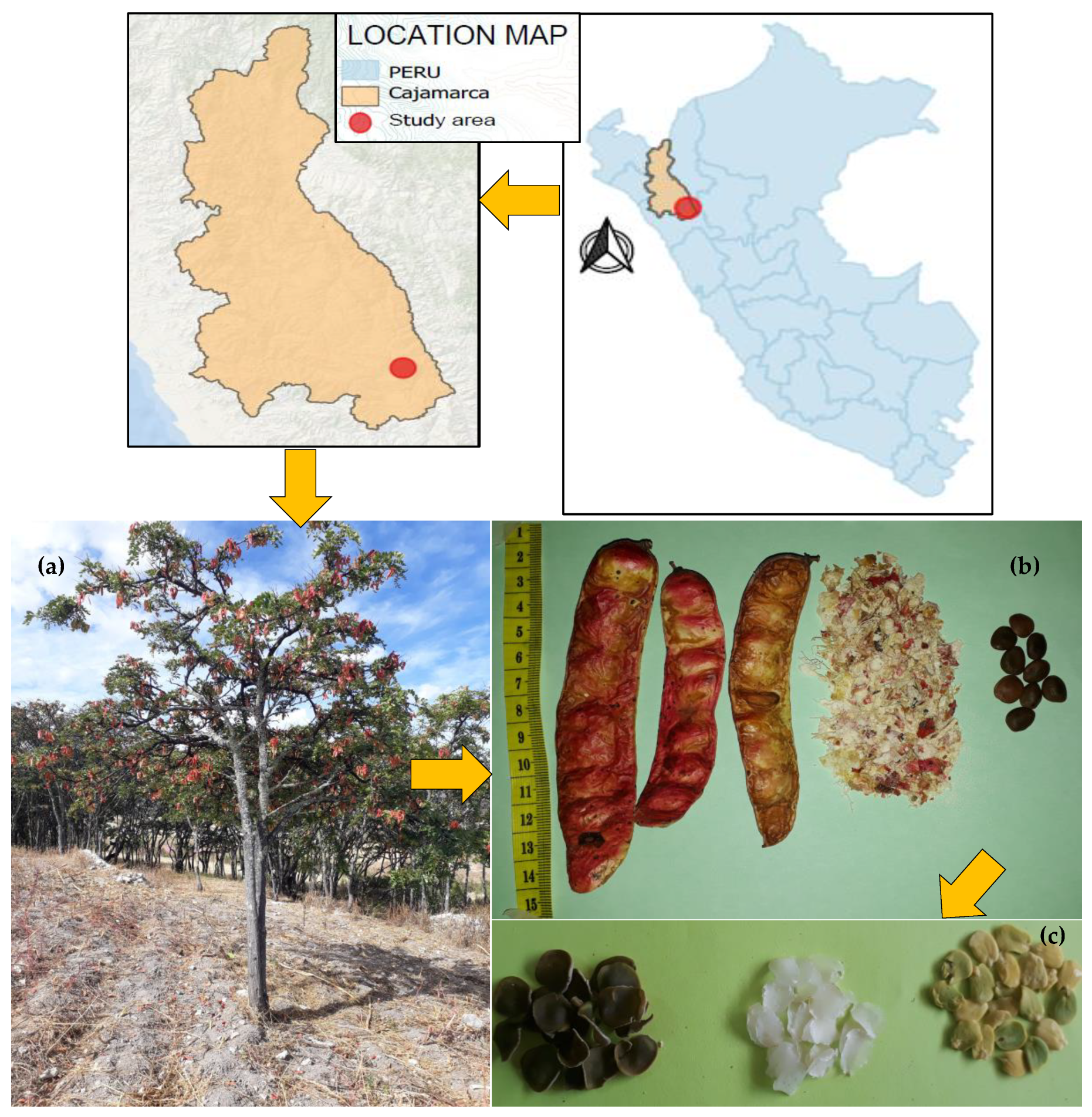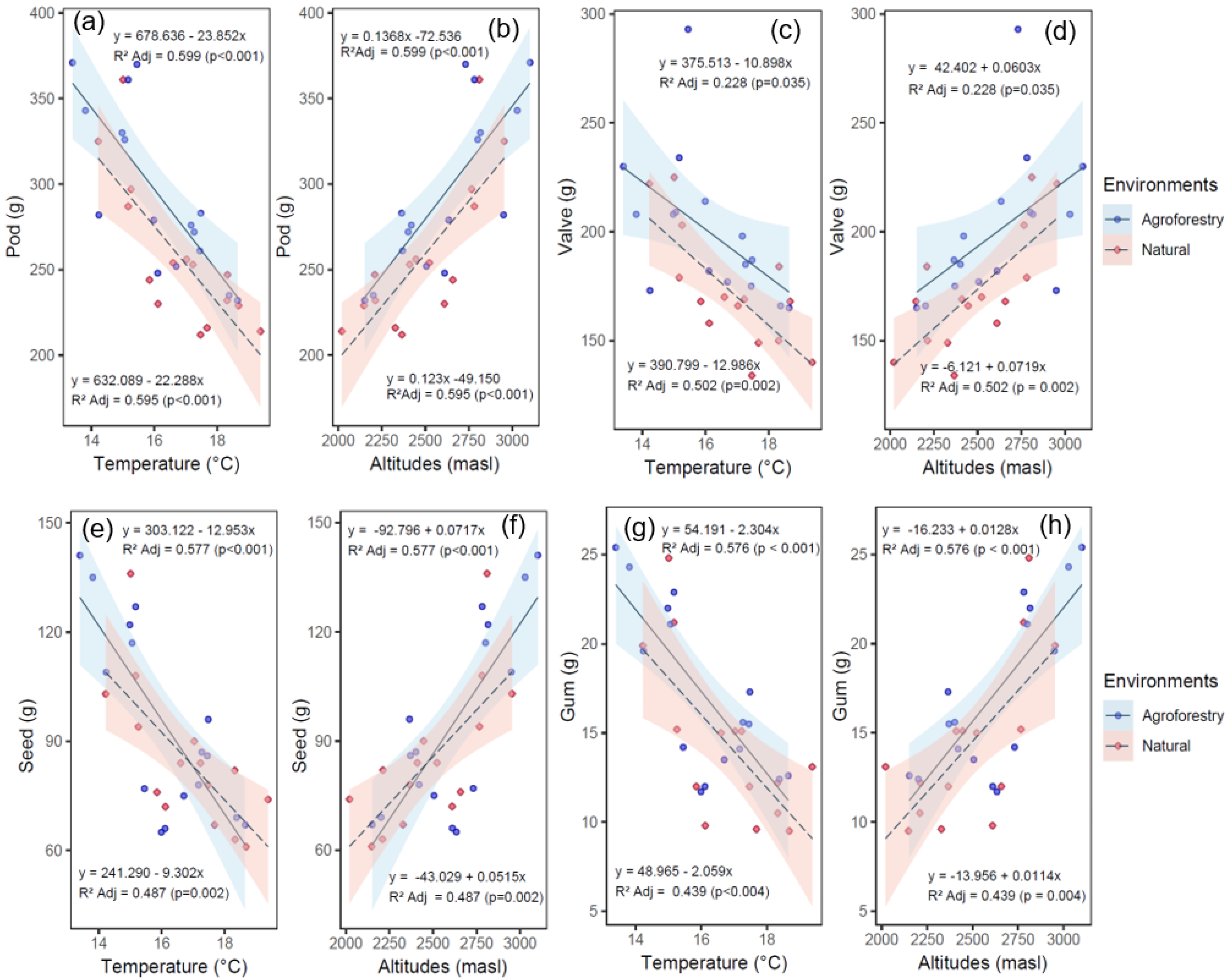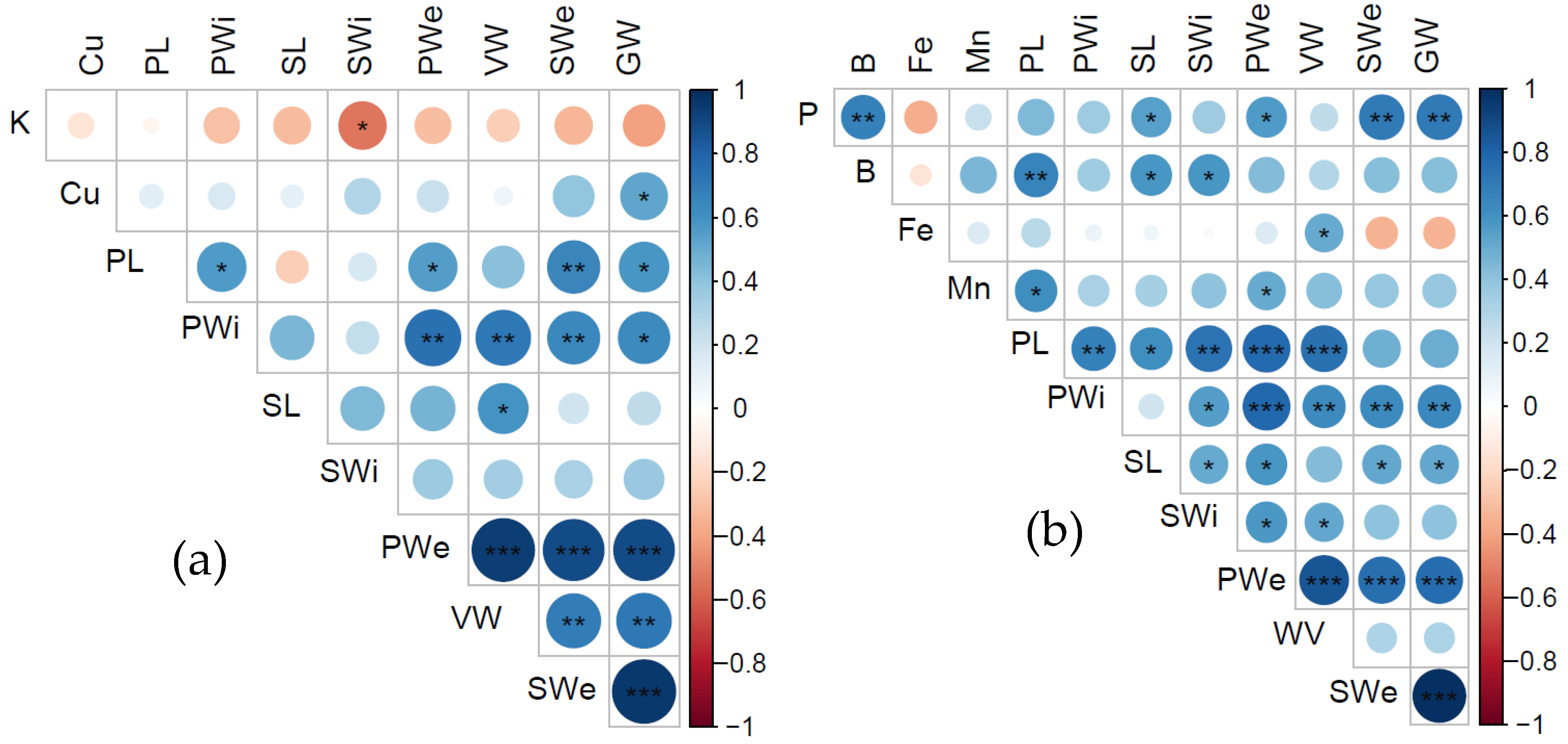Increased Production of Tara (Caesalpinia spinosa) by Edaphoclimatic Variation in the Altitudinal Gradient of the Peruvian Andes
Abstract
1. Introduction
2. Material and Methods
2.1. Characterization of the Study Area
2.2. Delimitation of Instalments
2.3. Soil Sampling and Analysis
2.4. Air Temperature Data
2.5. Physical Characterization of Pods and Seeds
2.6. Grouping of Variables
2.7. Statistical Analysis
3. Results
3.1. The Average Temperature of the Tara Reproductive Period
3.2. Dimensions of Pods and Seeds
3.3. Weight of Tara Pods, Valves, Seeds and Gum
4. Discussion
4.1. The Average Temperature of the Tara Reproductive Period
4.2. Tara Pod and Seed Dimensions and Weight
4.3. Influence of Altitude and Temperature on the Dimensions and Weight of Tara Pods
5. Conclusions
Supplementary Materials
Author Contributions
Funding
Data Availability Statement
Conflicts of Interest
References
- Ponce, S.; Chavarría, M.; Norabuena, F.; Chumpitaz, D.; Gutarra, A. Cellulose microfibres obtained from agro-industrial tara waste for dye adsorption in water. Water Air Soil Pollut. 2020, 231, 518. [Google Scholar] [CrossRef]
- Aguilar-Galvez, A.; Noratto, G.; Chambi, F.; Debaste, F.; Campos, D. Potential of tara (Caesalpinia spinosa) gallotannins and hydrolysates as natural antibacterial compounds. Food Chem. 2014, 156, 301–304. [Google Scholar] [CrossRef]
- He, D.; Li, Y.; Tang, H.; Ma, R.; Li, X.; Wang, L. Six new cassane diterpenes from the twigs and leaves of Tara (Caesalpinia spinosa Kuntze). Fitoterapia 2015, 105, 273–277. [Google Scholar] [CrossRef]
- Castro, A.J.; Ramos, N.J.; Juárez, J.R.; Ruiz, J.R.; Choquesillo, F.F.; Ponce, J.J.; Santa María, O.H.; Castillo, A.A.; García, D.A.; Escudero, J.; et al. Composición química del aceite esencial de Caesalpinia spinosa “Tara”, Evaluación antioxidante y efecto antibacteriano frente a Streptococcus mutans. Cienc. Investig. 2016, 19, 89–94. [Google Scholar] [CrossRef]
- Hadzich, A.; Flores, S.; Caprari, J.; Romagnoli, R. Study of zinc tannates prepared with Tara powder (Caesalpinia spinosa) as anticorrosive pigments in alkyd paints and wash primer formulations. Prog. Org. Coat. 2018, 117, 35–46. [Google Scholar] [CrossRef]
- Núñez-Ramos, J.E.; Quiala, E.; Posada, L.; Mestanza, S.; Sarmiento, L.; Daniels, D.; Arroyo, C.R.; Naranjo, B.; Vizuete, K.; Noceda, C.; et al. Morphological and physiological responses of tara (Caesalpinia spinosa (Mol.) O. Kuntz) microshoots to ventilation and sucrose treatments. Vitr. Cell. Dev. Biol.-Plant 2021, 57, 1–14. [Google Scholar] [CrossRef]
- Santander, S.P.; Aoki, M.; Hernandez, J.F.; Pombo, M.; Moins-Teisserenc, H.; Mooney, N.; Fiorentino, S. Galactomannan from Caesalpinia spinosa induces phenotypic and functional maturation of human dendritic cells. Int. Immunopharmacol. 2011, 11, 652–660. [Google Scholar] [CrossRef] [PubMed]
- Lasso, P.; Gomez-Cadena, A.; Urueña, C.; Donda, A.; Martinez-Usatorre, A.; Romero, P.; Barreto, A.; Fiorentino, S. An immunomodulatory gallotanin-rich fraction from Caesalpinia spinosa enhances the therapeutic effect of anti-PD-L1 in melanoma. Front. Immunol. 2020, 11, 2996. [Google Scholar] [CrossRef] [PubMed]
- Gámez-Espinosa, E.; Deyá, C.; Cabello, M.; Bellotti, N. Nanoparticles synthesized from Caesalpinia spinosa: Assessment of the antifungal effects in protective systems. Adv. Nat. Sci.: Nanosci. Nanotechnol. 2021, 12, 015001. [Google Scholar] [CrossRef]
- Ballesteros-Ramírez, R.; Durán, M.I.; Fiorentino, S. Genotoxicity and mutagenicity assessment of a standardized extract (P2Et) obtained from Caesalpinia spinosa. Toxicol. Rep. 2021, 8, 258–263. [Google Scholar] [CrossRef]
- Durán, M.L.; Mancheno, M. Actividad antifúngica de compuestos fenólicos de tara (Caesalpinia spinosa) frente a Fusarium graminearum. Rev. Investig. Agrar. Ambient. 2021, 12, 39–50. [Google Scholar] [CrossRef]
- Duran, M.I.; Ballesteros-Ramírez, R.; Tellez, A.; Torregrosa, L.; Olejua, P.A.; Galvis, S.; Urueña, C.; Fiorentino, S. Safety evaluation in healthy Colombian volunteers of P2Et extract obtained from Caesalpinia spinosa: Design 3+ 3 phase I clinical trial. Evid.-Based Complement. Altern. Med. 2022, 2022, 1–11. [Google Scholar] [CrossRef] [PubMed]
- Wu, Y.; Ding, W.; Jia, L.; He, Q. The rheological properties of tara gum (Caesalpinia spinosa). Food Chem. 2015, 168, 366–371. [Google Scholar] [CrossRef]
- Santos, M.B.; Dos Santos, C.H.C.; De Carvalho, M.G.; De Carvalho, C.W.P.; Garcia-Rojas, E.E. Physicochemical, thermal and rheological properties of synthesized carboxymethyl tara gum (Caesalpinia spinosa). Int. J. Biol. Macromol. 2019, 134, 595–603. [Google Scholar] [CrossRef]
- Rigano, L.; Deola, M.; Zaccariotto, F.; Colleoni, T.; Lionetti, N. A new gelling agent and rheology modifier in cosmetics: Caesalpinia spinosa gum. Cosmetics 2019, 6, 34. [Google Scholar] [CrossRef]
- Pedreschi, F.; Matus, J.; Bunger, A.; Pedreschi, R.; Huamán-Castilla, N.L.; Mariotti-Celis, M.S. Efecto de la adición integrada de extracto de vainas de tara roja (Caesalpinia spinosa) y NaCl sobre el contenido de contaminantes neoformados y propiedades sensoriales de galletas saladas. Moléculas 2022, 27, 1020. [Google Scholar] [CrossRef]
- Sundar, V.J.; Muralidharan, C. An environmentally friendly mineral-free tanning of animal skins–sustainable approach with plant resources. Environ. Process. 2020, 7, 255–270. [Google Scholar] [CrossRef]
- MINAGRI-Ministerio de Agricultura y Riego. Producción y Comercio de la Tara en el Perú; Boletín de la Dirección General de Políticas: Lima, Perú, 2019; 8p, Available online: https://cdn.www.gob.pe/uploads/document/file/419835/produccion-comercio-de-la-tara-peru.pdf (accessed on 30 November 2021).
- Sylvester, S.P.; Heitkamp, F.; Sylvester, M.D.; Jungkunst, H.F.; Sipman, H.J.; Toivonen, J.M.; Gonzales Inca, C.A.; Ospina, J.C.; Kessler, M. Relict high-Andean ecosystems challenge our concepts of naturalness and human impact. Sci. Rep. 2017, 7, 3334. [Google Scholar] [CrossRef]
- Kassa, H.; Dondeyne, S.; Poesen, J.; Frankl, A.; Nyssen, J. Impact of deforestation on soil fertility, soil carbon and nitrogen stocks: The case of the Gacheb catchment in the White Nile Basin, Ethiopia. Agric. Ecosyst. Environ. 2017, 247, 273–282. [Google Scholar] [CrossRef]
- Jacobi, J. Agroforestry in Bolivia: Opportunities and challenges in the context of food security and food sovereignty. Environ. Conserv. 2016, 43, 307–316. [Google Scholar] [CrossRef]
- Palacios Bucheli, V.J.; Bokelmann, W. Agroforestry systems for biodiversity and ecosystem services: The case of the Sibundoy Valley in the Colombian province of Putumayo. Int. J. Biodivers. Sci. Ecosyst. Serv. Manag. 2017, 13, 380–397. [Google Scholar] [CrossRef]
- Córdova, R.; Hogarth, N.J.; Kanninen, M. Sustainability of smallholder livelihoods in the Ecuadorian highlands: A comparison of agroforestry and conventional agriculture systems in the indigenous territory of Kayambi People. Land 2018, 7, 45. [Google Scholar] [CrossRef]
- Campos-Salas, N.; Casas, A.; Moreno-Calles, A.I.; Vallejo, M. Plant management in agroforestry systems of rosetophyllous forests in the Tehuacán Valley, Mexico. Econ. Bot. 2016, 70, 254–269. [Google Scholar] [CrossRef]
- Soler, R.; Chillo, V. Sinergias y antagonismos entre manejo agroforestal y conservación en paisajes multi-funcionales en Latinoamérica. Ecosistemas 2018, 27, 1–3. [Google Scholar] [CrossRef]
- Ruiz-Agudelo, C.A.; Hurtado Bustos, S.L.; Carrillo Cortés, Y.P.; Parrado Moreno, C.A. Lo que sabemos y no sabemos sobre los sistemas agroforestales tropicales y la provisión de múltiples servicios ecosistémicos. Una revisión. Ecosistemas 2019, 28, 26–35. [Google Scholar] [CrossRef]
- Wang, Z.; Yang, B.; Deslauriers, A.; Bräuning, A. Intra-annual stem radial increment response of Qilian juniper to temperature and precipitation along an altitudinal gradient in northwestern China. Trees 2014, 29, 25–34. [Google Scholar] [CrossRef]
- Hicks, L.C.; Meir, P.; Nottingham, A.T.; Reay, D.S.; Stott, A.W.; Salinas, N.; Whitaker, J. Carbon and nitrogen inputs differentially affect priming of soil organic matter in tropical lowland and montane soils. Soil Biol. Biochem. 2018, 129, 212–222. [Google Scholar] [CrossRef]
- De La Cruz-Amo, L.; Bañares-De-Dios, G.; Cala, V.; Granzow-De La Cerda, I.; Espinosa, C.I.; Ledo, A.; Salinas, N.; Macía, M.J.; Cayuela, L. Tradeoffs among aboveground, belowground, and soil organic carbon stocks along altitudinal gradients in Andean tropical montane forests. Front. Plant Sci. 2020, 11, 106. [Google Scholar] [CrossRef]
- Melo, F.; Glorio, P.; Spinosa, R. Efecto de la madurez en los componentes de valor comercial (taninos y goma) de Caesalpinia spinosa (Molina) Kuntze. Rev. Soc. Quím. Perú 2013, 79, 218–228. [Google Scholar]
- Murga-Orrillo, H.; Abanto-Rodríguez, C.; Polo Vargas, A.R. Aspectos biológicos y control de un gracilláriido (Gracillariidae: Lepidóptera) en Caesalpinia spinosa (Mol.) Kuntze (1898), en Cajamarca, Perú. Sci. Agropecu. 2016, 7, 93–102. [Google Scholar] [CrossRef]
- Murga-Orrillo, H.; Abanto-Rodríguez, C.; Fernandes Silva Dionisio, L.; Chu-Koo, F.W.; Schwartz, G.; Núñez Bustamante, E.; Stewart, P.M.; Santos Silva Amorim, R.; Vourlitis, G.L.; De Almeida Lobo, F.; et al. Tara (Caesalpinia spinosa) in Natural and Agroforestry Systems under an Altitudinal Gradient in the Peruvian Andes: Responses to Soil and Climate Variation. Agronomy 2023, 13, 282. [Google Scholar] [CrossRef]
- EMBRAPA. Adubação e Correção do Solo: Procedimentos a Serem Adotados em Função dos Resultados da Análise do Solo; 63 Circular Técnica: Campina Grande, Brasil, 2002; 32p, Available online: https://www.embrapa.br/busca-de-publicacoes/-/publicacao/275844/adubacao-e-correcao-do-solo-procedimentos-a-serem-adotados-em-funcao-dos-resultados-da-analise-do-solo (accessed on 18 December 2021).
- Jolliffe, I.T. Discarding variables in a principal component analysis, I: Artificial data. J. R. Stat. Soc. Ser. C Appl. Stat. 1972, 21, 160–173. [Google Scholar] [CrossRef]
- R Core Team. R: A Language and Environment for Statistical Computing; R Foundation for Statistical Computing: Vienna, Austria, 2021; Available online: https://www.R-project.org/ (accessed on 15 November 2021).
- Squire, G.; Obaga, S.Y.; Othieno, C. Altitud, temperatura y producción de brotes de té en las tierras altas de Kenia. Agric. Exp. 1993, 29, 107–120. [Google Scholar] [CrossRef]
- Wahba, M.M.; Fawkia, L.; Zaghloul, A. Management of calcareous soils in an arid region. Int. J. Environ. Pollut. Environ. Model. 2019, 2, 248–258. [Google Scholar]
- Munns, D.N.; Fox, R.L. Comparative lime requirements of tropical and temperate legumes. Plant Soil 1977, 46, 533–548. [Google Scholar] [CrossRef]
- Robson, A.D.; Edwards, D.G.; Loneragan, J.F. Calcium stimulation of phosphate absorption by annual legumes. Aust. J. Agric. Res. 1970, 21, 601–612. [Google Scholar] [CrossRef]
- Nascente, A.S.; Cobucci, T. Soil phosphorus availability and dry bean yield as affected by the application of liquid calcium carbonate micron particles on the furrow. Afr. J. Agric. Res. 2015, 10, 1840–1851. [Google Scholar] [CrossRef]
- Dejene, T.; Tana, T.; Urage, E. Response of common bean (Phaseolus vulgaris L.) to the application of lime and phosphorus on acidic soil of Areka, Southern Ethiopia. J. Nat. Sci. Res. 2016, 6, 90–100. [Google Scholar]
- Padbhushan, R.; Kumar, D. Influence of soil and foliar applied boron on green gram in calcareous soils. Int. J. Agric. Environ. Biotechnol. 2014, 7, 129. [Google Scholar] [CrossRef]
- Sheykhbaglou, R.; Sedghi, M.; Shishevan, M.T.; Sharifi, R.S. Effects of nano-iron oxide particles on agronomic traits of soybean. Not. Sci. Biol. 2010, 2, 112–113. [Google Scholar] [CrossRef]
- Worku, M.; De Meulenaer, B.; Duchateau, L.; Boeckx, P. Effect of altitude on biochemical composition and quality of green arabica coffee beans can be affected by shade and postharvest processing method. Food Res. Int. 2018, 105, 278–285. [Google Scholar] [CrossRef] [PubMed]
- Girma, B.; Gure, A.; Wedajo, F. Influence of Altitude on Caffeine, 5-Caffeoylquinic Acid, and Nicotinic Acid Contents of Arabica Coffee Varieties. J. Chem. 2020, 2020, 1–7. [Google Scholar] [CrossRef]
- Abebe, A.; Pathak, H.; Singh, S.D.; Bhatia, A.; Harit, R.C.; Kumar, V. Growth, yield and quality of maize with elevated atmospheric carbon dioxide and temperature in north-west India. Agric. Ecosyst. Environ. 2016, 218, 66–72. [Google Scholar] [CrossRef]
- Hovenden, M.J.; Brodribb, T. Altitude of origin influences stomatal conductance and therefore maximum assimilation rate in Southern Beech, Nothofagus cunninghamii. Funct. Plant Biol. 2000, 27, 451–456. [Google Scholar] [CrossRef]







| Station | 𝜙 | z | Station | 𝜙 | z | ||
|---|---|---|---|---|---|---|---|
| San Marcos | 7.32 | 78.17 | 2293 | Gregorio Pita | 7.23 | 78.21 | 2908 |
| Cajabamba | 7.62 | 78.05 | 2626 | La Fortuna | 7.67 | 78.40 | 3326 |
| Cachachi | 7.45 | 78.27 | 3228 | Lucma | 7.64 | 78.55 | 2225 |
| Cospan | 7.42 | 78.54 | 2423 | Magdalena | 7.25 | 78.65 | 1307 |
| Encañada | 7.12 | 78.33 | 2980 | Quiruvilca | 8.00 | 78.30 | 4047 |
| Altitude * | NS | PL | PW | SL | SW |
|---|---|---|---|---|---|
| m | cm | ||||
| Natural environment | |||||
| 2021 | 5.18 ± 1.21 | 9.34 ± 0.93 | 2.05 ± 0.16 | 0.58 ± 0.05 | 0.47 ± 0.05 |
| 2185 ± 37 | 4.23 ± 1.57 | 8.69 ± 0.93 | 2.22 ± 0.19 | 0.67 ± 0.09 | 0.46 ± 0.07 |
| 2388 ± 51 | 4.75 ± 1.36 | 8.54 ± 0.92 | 2.17 ± 0.21 | 0.64 ± 0.07 | 0.47 ± 0.08 |
| 2546 ± 62 | 4.36 ± 1.47 | 8.54 ± 1.30 | 2.04 ± 0.16 | 0.63 ± 0.08 | 0.45 ± 0.07 |
| 2680 ± 76 | 4.11 ± 1.54 | 9.01 ± 1.07 | 2.26 ± 0.21 | 0.69 ± 0.09 | 0.45 ± 0.07 |
| 2798 ± 21 | 5.80 ± 1.41 | 9.98 ± 1.31 | 2.42 ± 0.17 | 0.64 ± 0.06 | 0.48 ± 0.05 |
| 3007 | 3.88 ± 1.15 | 7.93 ± 0.87 | 2.14 ± 0.14 | 0.75 ± 0.08 | 0.51 ± 0.07 |
| Mean | 4.62 ± 0.68 | 8.86 ± 0.66 | 2.19 ± 0.13 | 0.66 ± 0.05 | 0.47 ± 0.02 |
| Agroforestry environment | |||||
| 2185 ± 35 | 4.43 ± 1.64 | 8.88 ± 1.02 | 2.15 ± 0.16 | 0.66 ± 0.07 | 0.43 ± 0.06 |
| M. sativa, L. multiflorum | |||||
| 2388 ± 26 | 4.80 ± 1.47 | 9.12 ± 0.96 | 2.30 ± 0.16 | 0.66 ± 0.08 | 0.48 ± 0.07 |
| Z. mays, P. vulgaris, T. aestivum | |||||
| 2546 | 3.88 ± 1.81 | 8.91 ± 1.28 | 2.14 ± 0.19 | 0.70 ± 0.10 | 0.48 ± 0.09 |
| Z. mays, P. vulgaris | |||||
| 2680 ± 64 | 3.62 ± 1.18 | 9.36 ± 1.51 | 2.38 ± 0.25 | 0.68 ± 0.07 | 0.48 ± 0.05 |
| Z. mays, P. vulgaris, M. sativa, L. multiflorum | |||||
| 2680 ± 64 | 5.06 ± 1.32 | 9.46 ± 0.98 | 2.53 ± 0.21 | 0.68 ± 0.08 | 0.49 ± 0.05 |
| Z. mays, P. vulgaris | |||||
| 3007 ± 76 | 5.26 ± 1.42 | 9.55 ± 1.17 | 2.41 ± 0.19 | 0.74 ± 0.06 | 0.50 ± 0.06 |
| Z. mays, V. faba, L. usitatissimum | |||||
| Mean | 4.51 ± 0.65 | 9.21 ± 0.29 | 2.32 ± 0.15 | 0.69 ± 0.03 | 0.48 ± 0.02 |
| Altitude * | Pod | Valve | Seed | Gum |
|---|---|---|---|---|
| m | g | |||
| Natural environment | ||||
| 2021 | 214 | 140 | 74 | 13 |
| 2185 ± 37 | 236 ± 10 | 167 ± 17 | 69 ± 12 | 11 ± 1 |
| 2388 ± 51 | 234 ± 23 | 155 ± 16 | 80 ± 10 | 13 ± 3 |
| 2546 ± 62 | 242 ± 17 | 164 ± 8 | 78 ± 8 | 12 ± 4 |
| 2680 ± 76 | 271 ± 37 | 186 ± 25 | 85 ± 13 | 14 ± 2 |
| 2798 ± 21 | 324 ± 52 | 202 ± 33 | 122 ± 20 | 23 ± 3 |
| 3007 | 325 | 222 | 103 | 20 |
| Mean | 264 ± 45 | 176 ± 28 | 87 ± 19 | 15 ± 5 |
| Agroforestry environment | ||||
| 2185 ± 35 | 234 ± 2 | 166 ± 1 | 68 ± 1 | 13 ± 0 |
| M. sativa, L. multiflorum | ||||
| 2388 ± 26 | 273 ± 9 | 186 ± 9 | 87 ± 7 | 16 ± 1 |
| Z. mays, P. vulgaris, T. aestivum | ||||
| 2546 | 252 | 177 | 75 | 14 |
| Z. mays, P. vulgaris | ||||
| 2680 ± 64 | 299 ± 63 | 230 ± 57 | 69 ± 7 | 13 ± 1 |
| Z. mays, P. vulgaris, M. sativa, L. multiflorum | ||||
| 2680 ± 64 | 339 ± 19 | 217 ± 15 | 122 ± 5 | 22 ± 1 |
| Z. mays, P. vulgaris | ||||
| 3007 ± 76 | 332 ± 46 | 204 ± 29 | 128 ± 17 | 23 ± 3 |
| Z. mays, V. faba, L. usitatissimum | ||||
| Mean | 274 ± 42 | 185 ± 27 | 89 ± 21 | 16 ± 4 |
Disclaimer/Publisher’s Note: The statements, opinions and data contained in all publications are solely those of the individual author(s) and contributor(s) and not of MDPI and/or the editor(s). MDPI and/or the editor(s) disclaim responsibility for any injury to people or property resulting from any ideas, methods, instructions or products referred to in the content. |
© 2023 by the authors. Licensee MDPI, Basel, Switzerland. This article is an open access article distributed under the terms and conditions of the Creative Commons Attribution (CC BY) license (https://creativecommons.org/licenses/by/4.0/).
Share and Cite
Murga-Orrillo, H.; Lobo, F.D.A.; Santos Silva Amorim, R.; Fernandes Silva Dionisio, L.; Nuñez Bustamante, E.; Chu-Koo, F.W.; López, L.A.A.; Arévalo-Hernández, C.O.; Abanto-Rodriguez, C. Increased Production of Tara (Caesalpinia spinosa) by Edaphoclimatic Variation in the Altitudinal Gradient of the Peruvian Andes. Agronomy 2023, 13, 646. https://doi.org/10.3390/agronomy13030646
Murga-Orrillo H, Lobo FDA, Santos Silva Amorim R, Fernandes Silva Dionisio L, Nuñez Bustamante E, Chu-Koo FW, López LAA, Arévalo-Hernández CO, Abanto-Rodriguez C. Increased Production of Tara (Caesalpinia spinosa) by Edaphoclimatic Variation in the Altitudinal Gradient of the Peruvian Andes. Agronomy. 2023; 13(3):646. https://doi.org/10.3390/agronomy13030646
Chicago/Turabian StyleMurga-Orrillo, Hipolito, Francisco De Almeida Lobo, Ricardo Santos Silva Amorim, Luiz Fernandes Silva Dionisio, Ever Nuñez Bustamante, Fred William Chu-Koo, Luís Alberto Arévalo López, César Oswaldo Arévalo-Hernández, and Carlos Abanto-Rodriguez. 2023. "Increased Production of Tara (Caesalpinia spinosa) by Edaphoclimatic Variation in the Altitudinal Gradient of the Peruvian Andes" Agronomy 13, no. 3: 646. https://doi.org/10.3390/agronomy13030646
APA StyleMurga-Orrillo, H., Lobo, F. D. A., Santos Silva Amorim, R., Fernandes Silva Dionisio, L., Nuñez Bustamante, E., Chu-Koo, F. W., López, L. A. A., Arévalo-Hernández, C. O., & Abanto-Rodriguez, C. (2023). Increased Production of Tara (Caesalpinia spinosa) by Edaphoclimatic Variation in the Altitudinal Gradient of the Peruvian Andes. Agronomy, 13(3), 646. https://doi.org/10.3390/agronomy13030646







